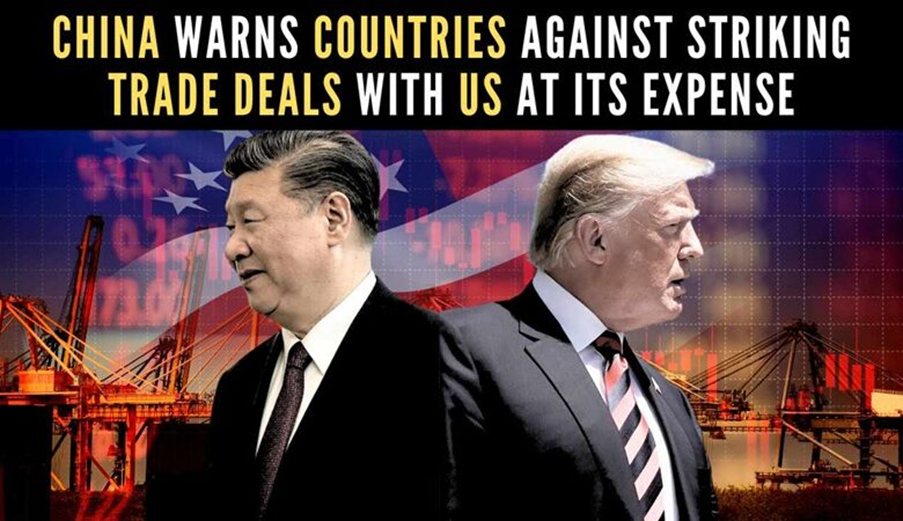Hit by the massive US import tariff, export-led China seems to have gone crazy as its No.1 export destination, the United States of America, has suddenly gone out of reach after US President Donald Trump’s prohibitive import tariff on China. Shockingly, China has issued a warning against countries seeking to strike a broader economic deal with the United States at its expense, ratcheting up its rhetoric in a spiralling trade war between the world’s two largest economies.
Notably, India, the second largest trade surplus destination of China after the US, is currently negotiating with the US for a new trade deal. With India’s exports to the US and imports from China reaching an all-time high in 2024-25, China is clearly worried about India’s possible import trade shift from China to the US. With the US, India had a merchandise trade surplus of $41.18 billion during the last financial year while its trade deficit with China reached a record level of over $99 billion. The US accounted for nearly 19.78 percent of India’s total exports and 6.29 percent of the total imports.
China proved to be India’s biggest avenue of foreign exchange drain as the country’s trade deficit with China reached an all-time high at $99.2 billion in 2024-25. China’s massive merchandise export push towards India witnessed a 17 percent export growth for China over the previous year while the country further stifled its imports from India. During the last fiscal, India’s exports to China decreased by 14.5 percent, reaching only $14.25 billion, a drop from $16.66 billion in the previous year.
With India now negotiating with the US for a fresh trade deal between the two countries, China is visibly upset. China has accused Washington of abusing its import tariff mechanism to corner the world’s largest exporter. Beijing will firmly oppose any party striking a deal at China’s expense and “will take countermeasures in a resolute and reciprocal manner,” its Commerce Ministry said in a statement. Ironically, the threat – if China is serious about its implementation – is expected to vastly benefit India. In fact, India should raise a massive import trade barrier against China to protect its industry and local employment until China allows substantial import of goods from India on a reciprocal basis to bridge the large trade gap.
The Trump administration is believed to be pressuring nations seeking tariff reductions or exemptions from the US to curb trade with China, including imposing monetary sanctions. President Trump has paused the sweeping tariffs on dozens of countries on April 2 except those on China, singling out the world’s second largest economy for the biggest merchandise import levies. Over the years, increasing imports from China have seriously impacted the growth of the domestic industry and employment in the US. Now, the US seems to be determined to arrest the trend. This explains President Trump’s move to raise tariffs on Chinese imports to 145 percent, prompting Beijing to slap retaliatory duties of 125 percent on US goods, effectively erecting trade walls against each other. “The United States has abused tariffs on all trading partners under the banner of so-called ‘equivalence’, while also forcing all parties to start so-called ‘reciprocal tariffs’ negotiations with them,” a Chinese Commerce ministry spokesperson said.
Chinese President Xi Jinping started hopping around the leading ASEAN countries with the intention of partly covering China’s export loss to the US. Not many ASEAN nations are, however, seemed to be convinced as they are also suffering from increasing trade deficits with China. President Xi Jinping visited some of the Southeast Asian countries in a move to bolster regional ties, calling on its ASEAN trade partners to oppose unilateral bullying by the US. ASEAN has 10 member countries including Brunei, Cambodia, Indonesia, Laos, Malaysia, Myanmar, the Philippines, Singapore, Thailand, and Vietnam. Interestingly, economic ministers from Thailand and Indonesia were recently in the US, with Malaysia set to join later last week, all seeking trade negotiations with the US administration. The trade between ASEAN and the US totalled around $476.8 billion in 2024, according to the US estimates, making Washington the regional bloc’s fourth-largest trading partner.
In fact, ASEAN accounts for China’s largest export destination. Last year, China’s exports to ASEAN reached US$586.52 billion, a 12 percent increase compared to the previous year. This growth has led to higher trade deficits for some ASEAN countries and has put pressure on local industries and employment due to the influx of Chinese goods. Increasing trade deficits with China have been haunting major ASEAN countries as in the case of India. Last year, Chinese exports to ASEAN grossed $586.52 billion (up 12 percent) while Chinese imports from ASEAN stood at only $395.81 billion. ASEAN’s exports to China saw a barely two percent growth.
China’s export growth to ASEAN countries has led to increasing trade deficits for some of the member nations and has put pressure on local industries due to the large influx of Chinese goods. Not many ASEAN countries trust China when it comes to trade. They find the US a much reliable trading partner. Last year, total merchandise trade between the US and ASEAN countries amounted to $476.8 billion. The US imports from ASEAN were $352.3 billion, a 13.3 percent increase from the previous year, leading to a US trade deficit with ASEAN at $227.7 billion, a 11.6 percent rise from 2023.
Under such circumstances, few countries are ready to take seriously China’s threat to retaliate against those trying to negotiate bilateral trade and economic deals with the US. Most of the countries, including India, find the US a more reliable trading partner than China. As for India, the country’s trade deficit with China has surged, reaching a record level, with imports from China far outpacing exports. China has been consistently blocking imports from India. It has also been using Nepal to push all kinds of Chinese goods into India. China has become India’s top import source in various industrial product categories. With the US-China trade relation having reached its nadir, there are strong concerns about Chinese exporters diverting production to India due to US tariffs and further resorting to dumping practices.
Fortunately, India and the US have already finalised the terms of the ongoing Bilateral Trade Agreement negotiations, aiming for balance and reciprocity in trade relations. According to US Treasury Secretary Scott Bessent, India may be the first country to sign a trade deal with the Trump administration. The trade pact is expected to boost market access, reduce tariffs, and bridge trade deficits for mutual benefits. (IPA Service)

 Supreme Court Clarifies Sharia Court Rulings Not Legally Binding
Supreme Court Clarifies Sharia Court Rulings Not Legally Binding 